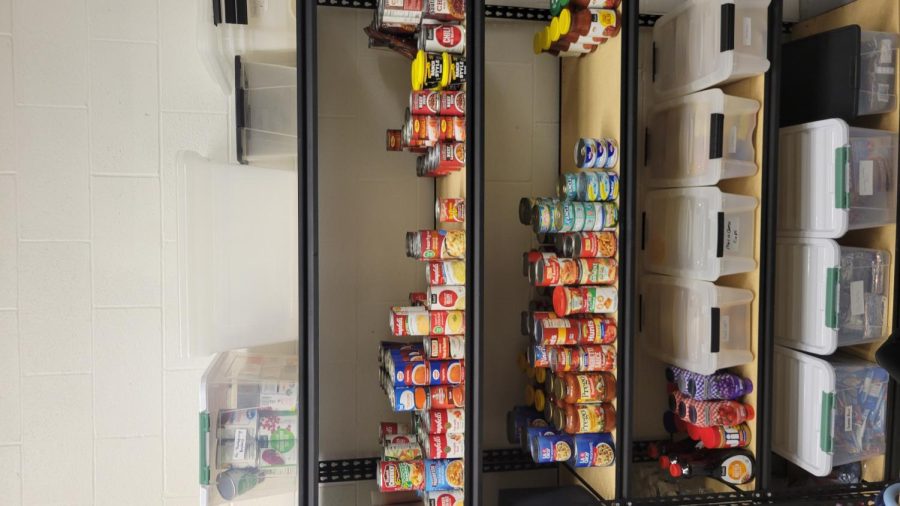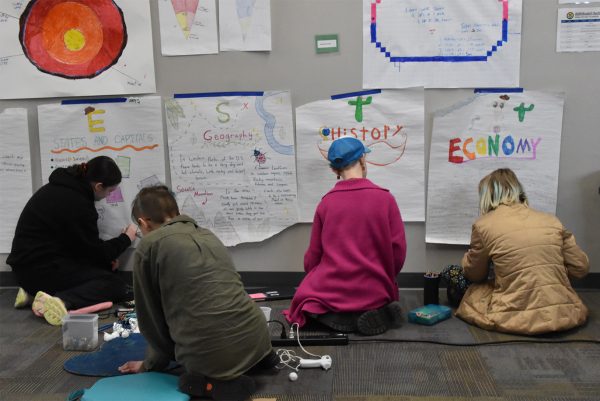What food insecurity is and how it’s affecting our community
Food insecurity affects hundreds of millions of people around the globe, millions in the United States, thousands in North Dakota, and hundreds in the Fargo Public Schools district.
Experiencing food insecurity as a child, and even when older, is mentally and emotionally exhausting. You see your parents skip meals to save money because you are more important to them as a child, and when you are finally old enough to understand, you feel responsible. You never want to ask for anything, no matter how important it is, because you don’t want to waste money; you feel guilty when your parents buy you something because you know they are financially struggling.
Being envious of well-off people because they don’t know what it’s like to be food insecure affects a person socially. Making friends is difficult because you never know how they perceive low-income people– the complex stigma associated with being unable to afford food. And when your friends invite you to do things that require money, such as shopping, going to the movies, or eating out, you have to decline because there is no money to spend, making you feel disconnected from your friends.
It is also detrimental to your relationship with food, either not wanting to eat because you don’t want to waste food on yourself or overeating because you don’t want the food to go to waste. Food insecurity is stressful because there is a constant worry in the back of your mind that you can’t shake. It’s tricky to overcome and recover from because it has a heavy negative impact.
But what is food insecurity? Food insecurity, as defined by the United States Department of Agriculture (USDA), is the limited or uncertain availability of nutritionally adequate and safe foods or the limited or uncertain ability to acquire acceptable foods in socially acceptable ways. In other words, not having consistent access to food. An example of not having constant food access is: Being unable to afford food, skipping meals, and relying on community food pantries or soup kitchens for necessary nutrition. Food insecurity means having no idea when your next meal will be.
This complex issue has been in the US for many years, but it was in the 1990s that data measuring food insecurity began to be collected. In 1990, the National Nutrition Monitoring and Related Research Act (NNMRR) was implemented to measure food insecurity rates.
Following that was the NNMRR’s Ten-Year Comprehensive Plan, which recommended “A standardized mechanism and instrument(s) for defining and obtaining data on the prevalence of ‘food insecurity or ‘food insufficiency’ in the United States and methodologies that can be used across the NNMRR Program and at State and local levels.” Then, to shorten the definition, they invented a method to measure food insecurity across the country to understand how many people struggled. And since the year 2001, assessments have been done annually.
Some may ask, “Why do people struggle with food insecurity?” It is an excellent question with an endless amount of answers. When asked what the leading causes of food insecurity are during an interview with Mary Krueger, North High’s student wellness and family facilitator, she said, “Unresolved trauma, mental health, poverty, and domestic violence are some explanations for food insecurity.” They aren’t the only causes, though. Geography is another factor in whether or not a family has available food. Areas called ‘food deserts’ refer to regions with mainly fast-food restaurants and little to no healthy, nutritious food needed for good health. Homelessness is another expected answer to food insecurity. If a person doesn’t have a home, they can’t get an ID for a job, which leads to an inability to make money for food.
Food insecurity is a frequent problem in the Fargo-Moorhead area. For example, 32.6% of West Fargo High School students qualify for free or reduced lunch. At Moorhead High School, 30.50% of students qualify for free or reduced-price lunch. Food insecurity affects the neighboring communities along with our own. The Fargo Public Schools district has 3,773 students under the free and reduced lunch program, about 33% of students. Our school, North High, has about 278 free and reduced lunch students, 69 students under reduced lunch, and 209 students for free lunch.
To help this problem of food insecurity, Fargo North has a small pantry called the ‘Open Door’ where a student can ask any staff member for access, and they can go to get what they need. The ‘Open Door’ is a small closet on the right side of the Spartan Dome upstairs. A student could find food, clothes, hygiene products, and even blankets for the upcoming cold weather; anything they could need.
But it doesn’t help alleviate the problem when homelessness rates are higher than they have been in the last two years. As of Nov. 7, 180 students at North, identified as homeless, while the number last year was 130. Compared to two years ago, that number has tripled according to the McKinney-Vento Homeless Assistance Act, which directs federal funds to homeless shelter programs.
One cause of the homelessness or food insecurity numbers rising is the COVID-19 pandemic. When COVID first hit and everywhere closed, many people lost their jobs. Even now, plenty of people still haven’t recovered from being unemployed. The result of people losing jobs is hundreds of thousands becoming food insecure, which has more than doubled in some regions (Feeding America.) For example, according to Feeding America, Massachusetts had a 59% increase in food insecurity from 2018 to 2020.
Not to mention that POC (people of color) communities are far more likely to face food insecurity. According to the USDA, in 2021, almost 20% of Black communities had a food insecure household and are nearly three times more likely than white people to go hungry. Also, 22% of Black children lived in food insecure households in 2021. People of color experience these significant rates of food insecurity for countless reasons: Employment, education, healthcare, housing, and mass incarceration can explain the higher rates of food insecurity than those of white communities.
The Latino community also struggles with large percentages of food insecurity rates. According to Feed America, Latinos were 2.5 times more likely than white people to be food insecure in 2021. One in every six Latino people was food insecure. Compared to white children, Latino children had a greater than twice increased risk of going hungry; in 2021, 18.5% of the Latino population and only 15% of white children were food insecure. Systemic racism is the root of all these problems for all those communities. Deeper problems such as past issues of slavery, segregation laws, years of oppression, racial prejudice, and plenty more can be explanations.
Food insecurity affects so many people around the world. It involves local, national, and even global communities. This is an issue that needs to be solved soon, or it is only going to get worse. But to do that, we need to come together to solve the problems that worsen food insecurity, like unemployment and systemic oppression. Though for now, you can take small steps like donating to local food banks, volunteering at shelters, or local fundraisers like Fill the Dome. If you see the chance to decrease the number of people struggling with food insecurity, take it. You’ll be helping your classmates, colleagues, and friends.
Your donation will support the student journalists of Fargo North High School. Your contribution will allow us to resume physical printing of our newspaper for students at Fargo North!
Hi! My name is Leyla, or Leyaunna depending on if I'm in trouble or not. I am a writer for the Fargo North Scroll! I really like cats and different types...





